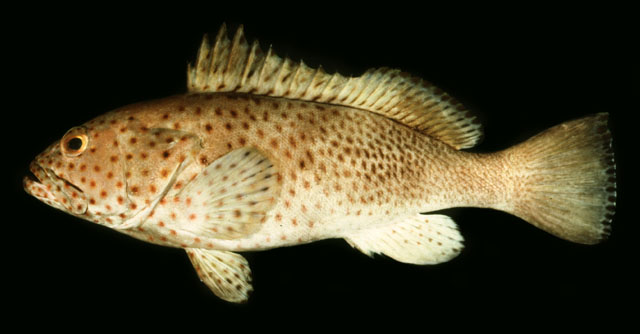| Epinephelidae (Groupers) |
| 55 cm TL (male/unsexed); max.weight: 2,700.0 g |
|
reef-associated; marine; depth range 1 - 70 m |
| Indo-West Pacific: Kenya to South Africa (32°S) and east to the Watubela Group of the eastern Banda Sea. Not known from the Red Sea nor Persian Gulf. |
|
Dorsal spines (total): 11-11; Dorsal soft rays (total): 16-17; Anal spines: 3-3; Anal soft rays: 8-8. Similar to E. maculatus but fewer spots and posterior ones elongated (Ref. 48635); Characterized by greyish brown color with pale blotches; head with widely scattered brown spots; diagonally elongated spots on body becoming more numerous posteriorly; dorsal fin with large dark blotches; ctenoid scales on body except cycloid on nape, thorax and lower abdomen; body with auxiliary scales; greatest depth of body 2.8-3.3 in SL; slightly rounded caudal fin; pelvic fins 1.8-2.3 in head length (Ref. 90102); head length 2.4-2.6 times in SL; flat to slightly convex interorbital area, convex dorsal head profile; preopercle angle with enlarged serrae and a shallow in indentation just above the angle; straight or slightly convex upper edge of operculum; posterior nostril not much larger than anterior nostril; maxilla reaches to or past vertical at rear edge of eye, ventral edge with blunt hook like process distally in fish larger than 35 cm SL; 2 rows of teeth on midlateral part of lower jaw (Ref. 89707). |
| Inhabit coral reefs or rocky areas and occasionally on sandy bottom. Feed mainly on crustaceans, especially crabs and stomatopods, rarely on small fishes, squids, and pelecypod flesh. Used in Chinese medicine (Ref. 12166). Solitary (Ref 90102). |
|
Least Concern (LC); Date assessed: 22 November 2016 Ref. (130435)
|
| harmless |
Source and more info: www.fishbase.org. For personal, classroom, and other internal use only. Not for publication.
